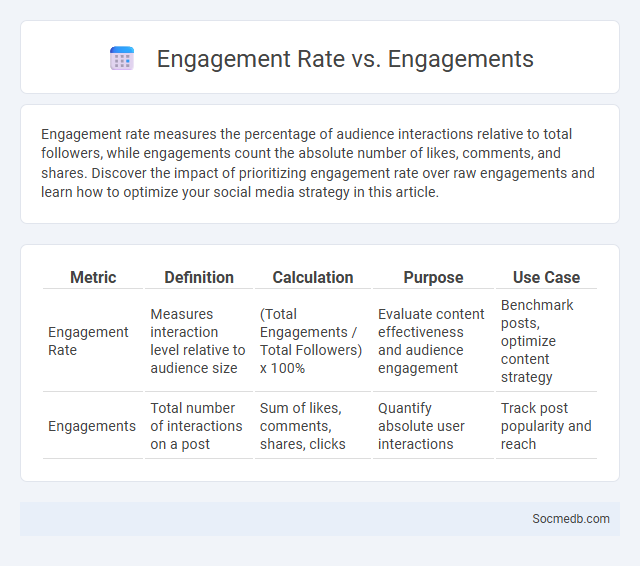
Photo illustration: Engagement Rate vs Engagements
Engagement rate measures the percentage of audience interactions relative to total followers, while engagements count the absolute number of likes, comments, and shares. Discover the impact of prioritizing engagement rate over raw engagements and learn how to optimize your social media strategy in this article.
Table of Comparison
| Metric | Definition | Calculation | Purpose | Use Case |
|---|---|---|---|---|
| Engagement Rate | Measures interaction level relative to audience size | (Total Engagements / Total Followers) x 100% | Evaluate content effectiveness and audience engagement | Benchmark posts, optimize content strategy |
| Engagements | Total number of interactions on a post | Sum of likes, comments, shares, clicks | Quantify absolute user interactions | Track post popularity and reach |
Understanding Engagement Rate: Definition and Importance
Engagement rate measures the level of interaction your social media content receives from your audience, including likes, comments, shares, and clicks relative to your follower count. This metric provides valuable insights into how effectively your posts resonate with your community and helps you tailor your strategy to boost visibility and brand loyalty. Tracking engagement rate regularly allows you to optimize content performance and maximize the impact of your social media efforts.
What Are Engagements? Breaking Down the Metrics
Engagements on social media refer to the interactions users have with content, including likes, comments, shares, saves, and clicks. These metrics provide insights into audience involvement and content effectiveness, helping brands measure reach and influence beyond mere follower counts. Analyzing engagement rates allows marketers to optimize strategies by identifying what resonates most with their target audiences.
Engagement Rate vs Engagements: Key Differences
Engagement Rate measures the percentage of your audience interacting with your content, providing insight into how effectively your posts resonate with followers. Engagements refer to the total number of interactions, such as likes, comments, and shares, reflecting overall activity but not relative audience size. Understanding the difference helps you evaluate content performance and tailor strategies to boost meaningful connections with your target audience.
Why Engagement Rate Matters for Social Media Success
Engagement rate is a crucial metric for social media success because it reflects how actively your audience interacts with your content through likes, comments, shares, and saves. Higher engagement rates signal quality content that resonates with your followers, boosting organic reach and brand visibility on platforms like Instagram, Facebook, and Twitter. Improving your engagement helps build a loyal community, enhances algorithm favorability, and drives meaningful connections that can convert followers into customers.
Calculating Engagement Rate: Formulas and Examples
Engagement rate on social media is calculated by dividing the total interactions (likes, comments, shares) by the total followers or impressions, then multiplying by 100 to express it as a percentage. Common formulas include Engagement Rate by Followers = (Total Engagements / Total Followers) x 100 and Engagement Rate by Reach = (Total Engagements / Total Reach) x 100. For example, if a post has 500 engagements and 10,000 followers, the engagement rate by followers is (500 / 10,000) x 100 = 5%.
Common Mistakes When Interpreting Engagement Metrics
Misinterpreting social media engagement metrics often leads to misguided strategies and wasted resources. You must avoid confusing high likes or shares with genuine audience loyalty, as these do not always translate to conversions or brand advocacy. Focusing solely on vanity metrics without analyzing click-through rates, comment sentiment, and follower growth can result in an incomplete understanding of your campaign's true impact.
Engagement Rate Benchmarks by Industry
Engagement rate benchmarks vary significantly across industries, with sectors like fashion and beauty often achieving higher rates around 3-5%, while technology and finance typically see lower averages near 1-2%. Social media platforms such as Instagram, Facebook, and TikTok each present unique engagement patterns, with TikTok generally generating the highest interaction levels due to its short-form video content. Tracking industry-specific engagement metrics enables marketers to tailor content strategies and set realistic performance goals aligned with platform trends and audience behavior.
How to Boost Both Engagement Rate and Engagements
To boost both engagement rate and total engagements on social media, focus on creating high-quality, relevant content tailored to your target audience's interests and preferences. Utilize interactive features such as polls, quizzes, and live videos to foster active participation, while consistently analyzing engagement metrics to optimize posting times and content formats for maximum reach. Incorporating user-generated content and personalized responses further enhances community interaction and loyalty, driving sustained engagement growth.
Choosing the Right Metric: When to Focus on Rate vs Total Engagements
Choosing the right social media metric depends on campaign goals: rate metrics like engagement rate are ideal for measuring audience interaction efficiency relative to reach, while total engagements quantify absolute user actions, providing insights into overall content popularity. Engagement rate highlights how effectively content resonates with the audience, crucial for brand awareness and community building. Total engagements are valuable for tracking viral content performance and gauging broad visibility across platforms.
Tools for Measuring Engagement Rate and Engagements
Social media analytics platforms like Sprout Social, Hootsuite, and Buffer offer powerful tools for measuring engagement rates and tracking interactions such as likes, comments, shares, and clicks. These tools provide detailed insights into audience behavior, helping you understand the effectiveness of your content strategy and optimize future posts for higher engagement. Monitoring your engagement metrics regularly allows you to tailor your social media efforts to better connect with your target audience and boost overall brand performance.
 socmedb.com
socmedb.com